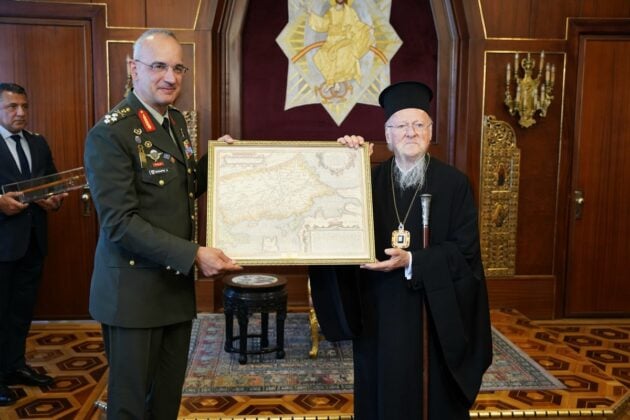

Greece dismissed Turkey’s recent criticism Friday over a historic map presented as a gift to Ecumenical Patriarch Bartholomew by General Dimitrios Choupis, Chief of the Hellenic National Defense General Staff, saying the gift was “purely symbolic.”
According to Greek Defense Ministry sources, “Complaints about a map from this specific historical period by sources within the Turkish Defense Ministry – a country that in 2025 still invokes the Blue Homeland map- border the absurd.”
The same sources noted that the map was selected because it depicts the Ecumenical Patriarch’s homeland, Imbros.
The map that angered Ankara was a copy of the “Thraciae Veteris Typus” (Latin for “Map of Ancient Thrace”). The historical map was created by Flemish cartographer Abraham Ortelius and was first published in 1585 as part of his famous atlas “Theatrum Orbis Terrarum” (“Theater of the World”). It depicts the ancient region of Thrace, which historically covers parts of modern northeastern Greece, Bulgaria and Turkey, including the Dardanelles Straits, the Propontis, the Bosphorus, and the islands of Imbros and Tenedos.
General Choupis offered the map to Patriarch Bartholomew during his visit to the Greek Orthodox Patriarchate in Istanbul, on the sidelines of the 18th Summit of the Chiefs of Armed Forces of the Balkan Countries.
According to Turkish media, the gift provoked a reaction from Turkey’s Defense Ministry, with anonymous sources criticizing the gesture as an attempt to “instrumentalize the past,” dismissing it as “nostalgic consolations” and calling on Greek officials to “understand and accept the facts.”

Thrace is a province of Greece rooted in thousands of years of history. Located in southeastern Europe, Thrace is a historically and culturally significant region with a fascinating history that spans millennia.
Today, three different countries share parts of this ancient area’s influence: Greece, Bulgaria and Turkey.
The Thracians were well-known in ancient times for their military strength. Because of their excellent physical abilities, many men from Thrace worked as mercenaries in the armies of ancient Greece and Rome.
The significant cultural blending between the south of the Greek peninsula and the southeastern part of Europe resulted in the gradual Hellenization of many sections of Thrace, especially in the south of the region.
At the same time, the Macedonian Empire, led by King Philip II and later his son, Alexander the Great, took easy control of Thrace in the fourth century BC. After Alexander the Great died, the region became a battleground for his successors and a hotspot for Greek dominance.
In the first century AD, the emerging superpower of the known world, Rome, captured Thrace and incorporated it into its expanding empire as the province of Thracia.
Following the fall of the Western Roman Empire, Thrace became part of the Eastern Roman (Byzantine) Empire. The fact that region was in such a strategic location very close to Constantinople, made it a popular target for invading troops, including Goths, Huns and Slavs.
The region eventually came under Ottoman administration, which lasted for about five centuries. During that time, substantial demographic changes occurred within Thrace, such as the settlement of many Turkish populations and the conversion of certain natives from Christianity to Islam, for mere reasons of survival.
Following the fall of the Ottoman Empire and the establishment of the modern Turkish Republic, state borders in Thrace changed significantly.
The modern partition of Thrace dates back to the late 19th and early 29th centuries. A number of conflicts took place during this time and subsequent treaties defined the borders many times.
In 1920, following the end of World War I, the Treaty of Sèvres was signed between the Allied Powers, who had won the war and the Ottoman Empire.
This monumental treaty for Athens granted Greece control over most of what is today Eastern Thrace, except the zone of the Straits (Bosphorus and Dardanelles) along with Constantinople (Istanbul).
Today, Thrace is a region where three countries meet, two of them full member-states of the European Union. Each one of them keeps its unique cultural history while sharing a similar historical inheritance of the broader region of Thrace.
Today, northern Thrace is part of southern Bulgaria and the E.U., as is Western Thrace in the northeastern part of Greece. Eastern Thrace is Turkey’s only European region right west of the big metropolitan center of Istanbul (Constantinople).
